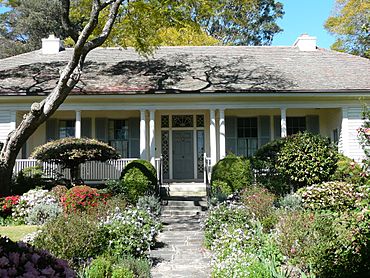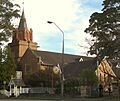Gordon, New South Wales facts for kids
Quick facts for kids GordonSydney, New South Wales |
|||||||||||||||
|---|---|---|---|---|---|---|---|---|---|---|---|---|---|---|---|

Eryldene, a heritage-listed home built circa 1913
|
|||||||||||||||
| Population | 8,795 (2021 census) | ||||||||||||||
| • Density | 2,321/km2 (6,010/sq mi) | ||||||||||||||
| Established | 1823 | ||||||||||||||
| Postcode(s) | 2072 | ||||||||||||||
| Elevation | 126 m (413 ft) | ||||||||||||||
| Area | 3.79 km2 (1.5 sq mi) | ||||||||||||||
| Location | 14 km (9 mi) north-west of Sydney CBD | ||||||||||||||
| LGA(s) | Ku-ring-gai Council | ||||||||||||||
| State electorate(s) | Davidson | ||||||||||||||
| Federal Division(s) | Bradfield | ||||||||||||||
|
|||||||||||||||
Gordon is a friendly suburb located on Sydney's Upper North Shore in New South Wales, Australia. It's about 14 kilometers (9 miles) north-west of the main city area, the Sydney Central Business District. Gordon is also special because it's where the main offices for the Ku-ring-gai Council are located. You'll find areas like East Gordon within the suburb, and West Gordon is part of nearby West Pymble.
Contents
Exploring Gordon's Location
Gordon is found on the northern edge of Sydney, about 18 kilometers from the city center. Most of the suburb is made up of homes. It is surrounded by beautiful bushland along the banks of Stony Creek.
Gordon's Past: A Brief History
The name 'Gordon' first appeared on maps as a survey area for the upper north shore. It was named by Sir Thomas Mitchell, a famous explorer. He likely named it after Sir Willoughby Gordon, a friend he served with in the army.
People started settling in this area around 1820. The early settlement was first called Lane Cove. The very first school in 'Lane Cove' (which was Gordon back then) was set up in 1816. The first Lane Cove Post Office opened in 1860.
The name of the village and Post Office officially changed to Gordon in 1879. This new name came from the 'Gordondale' estate, which belonged to Robert McIntosh. The North Shore Line got its Gordon Railway Station in 1888.
The first meeting of the Ku-ring-gai Shire Council happened in Gordon in 1906. In 1911, a small building was built for the Council. Gordon is still the main place for local government in the area today.
Gordon Public School's Story
The old Gordon Public School building was built in 1878. It was designed in a Gothic Revival style, which was popular for schools and churches back then. Another part was added in 1912.
This school was first called Lane Cove School. Its name officially changed to Gordon Public School in 1885. These old school buildings are some of the few remaining from the early days of northern Sydney. The school closed in 1989. However, Gordon East Public School and Gordon West Public School are still open nearby.
Historic Places in Gordon
Gordon has several places that are listed for their historical importance. These are called heritage-listed sites. They include:
- 17 McIntosh Street: Eryldene, a beautiful old home.
- Middlemiss Street: Gordon railway station, a historic train station.
- 691 Pacific Highway: Iolanthe, another heritage home.
- 707 Pacific Highway: Tulkiyan, a special house.
- 799 Pacific Highway: Gordon Public School (former), the old school building.
Gordon is also home to Sydney's largest colony of flying foxes. Land was bought to protect these amazing creatures.
Famous People from Gordon
Many notable people have lived in Gordon:
- Dr John Bradfield (1867–1943) was the chief engineer for the Sydney Harbour Bridge. He lived in Gordon and is buried there.
- Tim Schenken, a Formula One race car driver, was born in Gordon.
- Annie Forsyth Wyatt started the National Trust in Australia. She lived in a small cottage in Park Avenue.
- Professor Eben Gowrie Waterhouse was a language expert and camellia breeder.
- Clover Moore, who is now the Lord Mayor of Sydney, grew up in Gordon.
Getting Around: Transport in Gordon
Gordon is on a main road called the Pacific Highway. It's also near the intersection of Ryde and Mona Vale roads. These roads connect different parts of Sydney, like the Northern Beaches and Homebush Bay.
Gordon railway station is part of the Sydney Trains network. Trains run often, with express services during busy times. The station was built in 1888 and has lovely landscaped gardens. It's a great example of a historic Edwardian station. Lifts have recently been added to the platforms.
Outside the station, there's a bus stop. Buses from here go to places like St Ives, West Pymble, Mona Vale, and Macquarie University.
Places of Worship and Learning
Gordon has several churches:
- St Johns Anglican Church, which has a cemetery.
- Gordon Uniting Church.
- Gordon Baptist Church.
- The Liberal Catholic Church of St. Francis.
Gordon is also home to two schools:
- Gordon East Public School (for Kindergarten to Year 6).
- Ravenswood School for Girls (for Kindergarten to Year 12).
Gordon West Public School is named after Gordon, but it is actually located in West Pymble. Gordon Community Preschool helps children aged 3 to 5 years old.
Shopping and Services
Gordon has a busy shopping area with many stores and restaurants. These are mostly along the Pacific Highway and near Gordon railway station.
Gordon Centre is a shopping mall that has a Harvey Norman and a Woolworths supermarket. It also has many other shops and offices. Gordon Centre used to be a department store before it became a shopping center in 1985. There's also a McDonald's nearby.
Gordon Village Arcade is another shopping area with various stores, including a post office. Gordon Private Hospital is located on the Pacific Highway. It helps people with mental health and is also a teaching hospital.
The main offices for the Ku-ring-gai Council are located in Gordon.
Visiting Gordon: Tourism
Gordon is mostly a place where people live. It's known for its leafy streets and charming suburban feel. It's close to nature, offering a peaceful escape from the busy city.
While it's not a major tourist spot, Gordon has lovely heritage homes. Some of these homes date back to the late 1800s and early 1900s. They are listed on the New South Wales State Heritage Register. Gordon offers a quiet and pretty place to relax, with easy access to all of Sydney's attractions.
Sports in Gordon
Rugby Union is a very popular sport in Gordon. The Gordon Rugby Football Club, also known as the Gordon Highlanders, plays in the Shute Shield. The Gordon Gazelles play in the Sydney Women's Premier Rugby. Both the rugby and cricket clubs play at Chatswood Oval.
In Rugby League, Gordon is represented by the North Sydney Bears. Even though they are not in the top league anymore, they are still a very important club. Junior Rugby League teams in the area, including the Ku-ring-gai Cubs, play at Memorial Park in Turramurra.
Homes and Architecture
Eryldene is a historic house in Gordon that you can visit. It's on McIntosh Street. The house was designed for Professor Eben Gowrie Waterhouse and built around 1913. The large garden is also very special. Both the house and garden are listed as important heritage sites.
Another famous home is Tulkiyan, on the Pacific Highway. This house was designed by Bertrand James Waterhouse, a well-known architect. He designed Tulkiyan in the Arts and Crafts style. The land for Tulkiyan was first granted in 1823. The house stayed with the same family until 1994, when it was given to Ku-ring-gai Council. Tulkiyan is also a state heritage-listed site.
The Arts and Crafts style was popular during the Federation period (1890 to 1915). Other styles from this time include the Federation Queen Anne and Federation Bungalow styles. You can see good examples of the Federation Bungalow style on Nelson Street in Gordon.
Nebraska, in Yarabah Avenue, is another unique home designed by architect Alexander Stewart Jolly. It looks a bit like a log cabin and has interesting stonework. It is also heritage-listed.
In Gordon, about 45% of homes are separate houses. About 48% are flats, units, or apartments. The average household has about 2.7 people.
People of Gordon
At the 2021 census, there were 8,795 people living in Gordon.
- The average age in Gordon is 39, which is similar to the rest of New South Wales. About 15.8% of people are 65 years or older.
- 44.2% of people were born in Australia. Many others were born in China (16.0%), South Korea (4.3%), Hong Kong (4.2%), England (3.6%), and Taiwan (2.3%).
- 48.1% of people speak only English at home. Other languages spoken include Mandarin (20.2%), Cantonese (9.0%), Korean (5.0%), Persian (2.2%), and Japanese (1.3%).
- The average household income in Gordon is $2,460 per week, which is higher than the national average.
- About 35.3% of people in Gordon rent their homes. 32.3% own their home outright, and 30.6% have a mortgage. The average weekly rent is $577, and the average monthly mortgage payment is $3,033.
- When asked about religion, 46.2% of people said they had no religion. Other religions included Catholic (12.7%), Anglican (10.6%), and Buddhist (4.4%).
Images for kids
See also
 In Spanish: Gordon (Nueva Gales del Sur) para niños
In Spanish: Gordon (Nueva Gales del Sur) para niños










